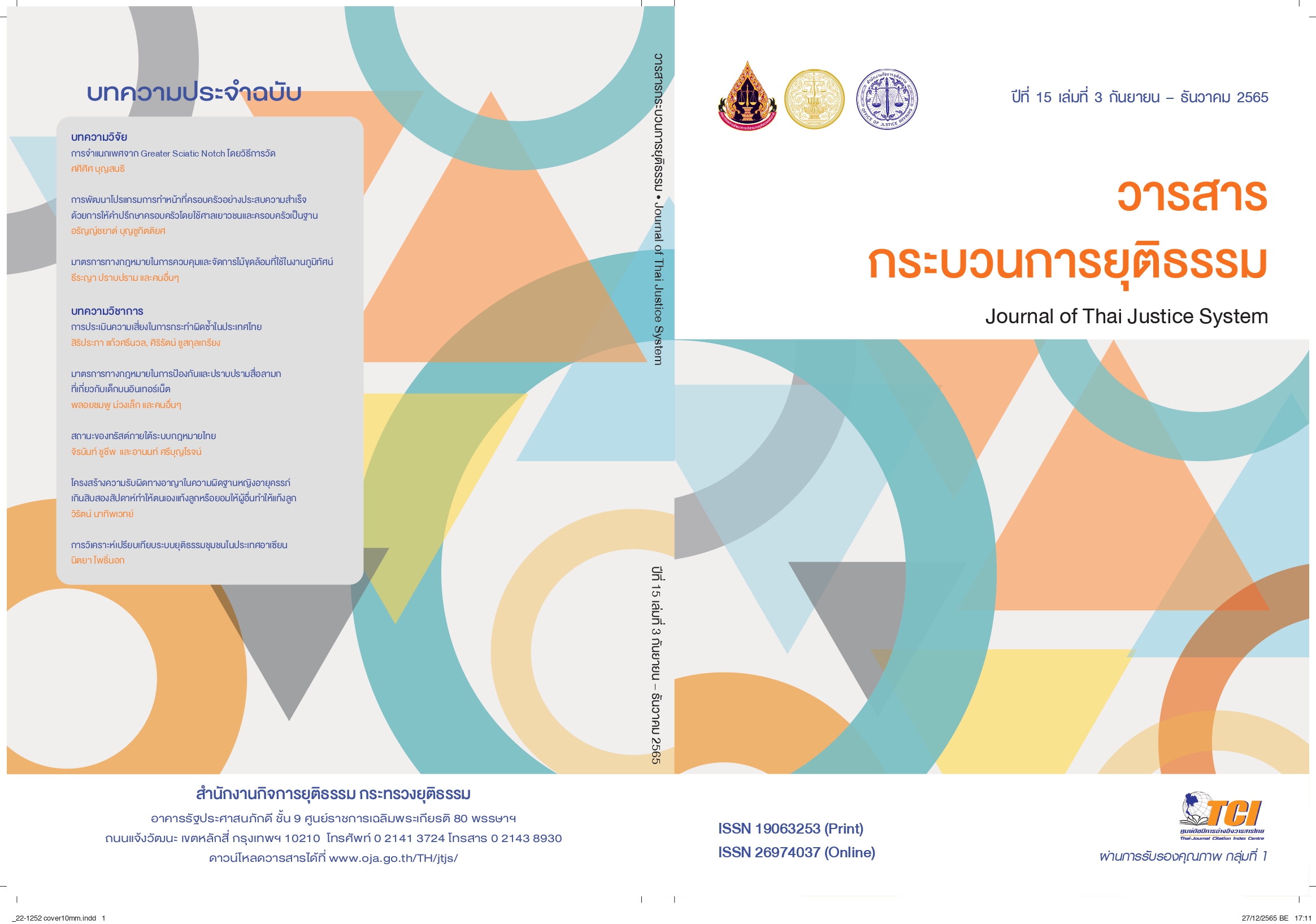มาตรการทางกฎหมายในการป้องกันและปราบปรามสื่อลามกที่เกี่ยวกับเด็กบนอินเทอร์เน็ต
Main Article Content
บทคัดย่อ
การวิจัยนี้มีวัตถุประสงค์เพื่อวิเคราะห์และเสนอแนะแนวทางปรับปรุงกฎหมายในการป้องกันและปราบปรามสื่อลามกที่เกี่ยวกับเด็กบนอินเทอร์เน็ต ผลของการวิจัยพบว่าในปัจจุบันประเทศไทยได้ปรับปรุงมาตรการทางกฎหมายเพื่อใช้ในการป้องกันและปราบปรามสื่อลามกที่เกี่ยวกับเด็กบนอินเทอร์เน็ตเป็นการเฉพาะแล้ว โดยได้แก้ไขเพิ่มเติมประมวลกฎหมายอาญามาตรา 287/1: ความผิดฐานครอบครองสื่อลามกอนาจารเด็กเพื่อแสวงหาประโยชน์ในทางเพศหรือส่งต่อซึ่งสื่อลามกอนาจารเด็กและมาตรา 287/2: ความผิดฐานทำหรือประกอบการค้าหรือโฆษณาเกี่ยวกับสื่อลามกอนาจารเด็กและเพิ่มบทนิยามในมาตรา 1 (17): คำว่า “สื่อลามกอนาจารเด็ก”ซึ่งแสดงให้เห็นได้ว่ากฎหมายไทยให้ความคุ้มครองเด็กจากสื่อลามกที่เกี่ยวกับเด็กบนอินเทอร์เน็ตให้แก่เด็กอายุไม่เกิน 18 ปีและได้แก้ไขเพิ่มเติมพระราชบัญญัติว่าด้วยการกระทำความผิดเกี่ยวกับคอมพิวเตอร์ พ.ศ.2550 มาตรา 15 กำหนดความผิดอาญาและบทยกเว้นโทษของผู้ให้บริการอินเทอร์เน็ตประเภทให้บริการเข้าใช้เครือข่ายอินเทอร์เน็ต (access provider) ไว้ด้วย ซึ่งสอดคล้องกับมาตรฐานสากลและมีความเหมาะสมแล้ว
อย่างไรก็ตามการกำหนดถ้อยคำในมาตรา 287/1และมาตรา 287/2 แห่งประมวลกฎหมายอาญาโดยใช้ถ้อยคำว่า “สื่อลามกอนาจารเด็ก” อาจทำให้เกิดความสับสนในการตีความกฎหมาย ผู้วิจัยจึงมีข้อเสนอแนะว่าควรปรับปรุงถ้อยคำในมาตรา 1 (17) มาตรา 287/1 และมาตรา 287/2 แห่งประมวลกฎหมายอาญา โดยแก้ไขคำว่า “สื่อลามกอนาจารเด็ก” เป็นคำว่า “สื่อลามกเด็ก”
Article Details

อนุญาตภายใต้เงื่อนไข Creative Commons Attribution-NonCommercial-NoDerivatives 4.0 International License.
ต้นฉบับที่ได้รับการตีพิมพ์ในวารสาร เป็นลิขสิทธิ์ของวารสารกระบวนการยุติธรรม แต่ความคิดเห็นที่ปรากฏในเนื้อหาของบทความในวารสารกระบวนการยุติธรรม ถือเป็นความรับผิดชอบของผู้เขียนแต่เพียงผู้เดียว
เอกสารอ้างอิง
กระทรวงเทคโนโลยีสารสนเทศและการสื่อสารและศูนย์เทคโนโลยีอิเล็กทรอนิกส์และคอมพิวเตอร์แห่งชาติ. (2548).Privacy Policy&Trustmark: กลไกการคุ้มครองข้อมูลส่วนบุคคลกับการสร้างความน่าเชื่อถือในการทำ e-Business. กรุงเทพฯ: ศูนย์เทคโนโลยีอิเล็กทรอนิกส์และคอมพิวเตอร์แห่งชาติกระทรวงวิทยาศาสตร์และเทคโนโลยี.
คณิต ณ นคร. (2553). กฎหมายอาญาภาคความผิด. กรุงเทพฯ: วิญญูชน.
จิตติ ติงศภัททิย์. (2513). คำอธิบายประมวลกฎหมายอาญาภาค 2 ตอนที่ 2 และภาค 3. กรุงเทพฯ: วิญญูชน.
เนติ รัตนากร. (2542). การให้ความคุ้มครองเด็กตามกฎหมายควบคุมสื่อลามก : ศึกษาเปรียบเทียบกฎหมายไทยอังกฤษ สหรัฐอเมริกา และเยอรมัน. วิทยานิพนธ์ปริญญานิติศาสตร์มหาบัณฑิต. มหาวิทยาลัยธรรมศาสตร์.
วราภรณ์ วนาพิทักษ์. (2550).มาตรการการจัดการเนื้อหาที่ไม่เหมาะสมบนอินเทอร์เน็ตในประเทศไทย. วิทยานิพนธ์ปริญญาปรัชญาดุษฏีบัณฑิต. มหาวิทยาลัยธรรมศาสตร์.
ทวีเกียรติ มีนะกนิษฐ. (2557). คำอธิบายประมวลกฎหมายอาญา ภาคความผิดและลหุโทษ. (11) กรุงเทพฯ: วิญญูชน.
สัญเพ็ชญ์ โพธิ์หล้า. (2545). อำนาจรัฐในการควบคุมวัตถุลามก.วิทยานิพนธ์ปริญญานิติศาสตร์มหาบัณฑิต. มหาวิทยลัยรามคำแหง.
สุชา จันทน์เอม. (2536). จิตวิทยาพัฒนาการ. กรุงเทพฯ: ไทยวัฒนาพานิชย์.
โสมนัส เจือศรีกุล. (2545). มาตรการควบคุมต่อต้านสื่อลามกเด็ก. วิทยานิพนธ์ปริญญานิติศาสตร์มหาบัณฑิต. จุฬาลงกรณ์มหาวิทยาลัย.
องค์กรยูนิเซฟประเทศไทย. (2545). คู่มือ ECPAT: ปกป้องน้องน้อยจากภัยออนไลน์. กรุงเทพฯ: ECPAT International.
iLaw. (2556). ร่างพ.ร.บ.คอมพิวเตอร์ ฉบับ สพธอ.2556 : โทษคุกฐานก้อปปี้ไฟล์เก็บภาพโป้เด็ก. ค้นเมื่อ 14 มิถุนายน 2562, จาก http://ilaw.or.th/node/2728
Internet Free Expression Alliance. (2001).TITLE XVII--CHILDREN'S INTERNET PROTECTION. Retieved May 25, 2019, from http://ifea.net/cipa.pdf
Unicef. (2001).Laws of Malaysia, Act 611 Child Act 2001. Retieved May 25, 2019, from http://www.unicef.org/Malaysia/Child-Act-2001.pdf


